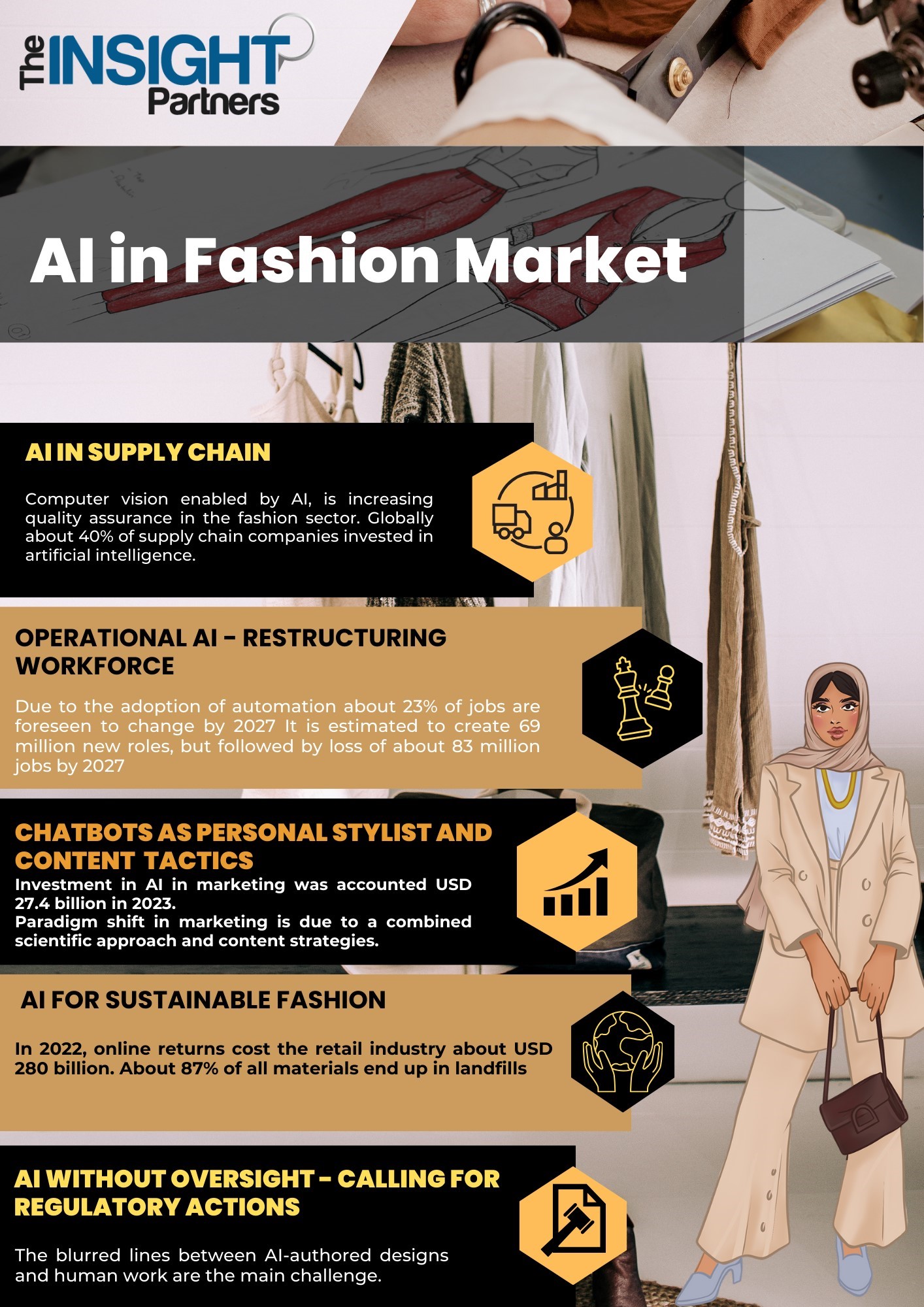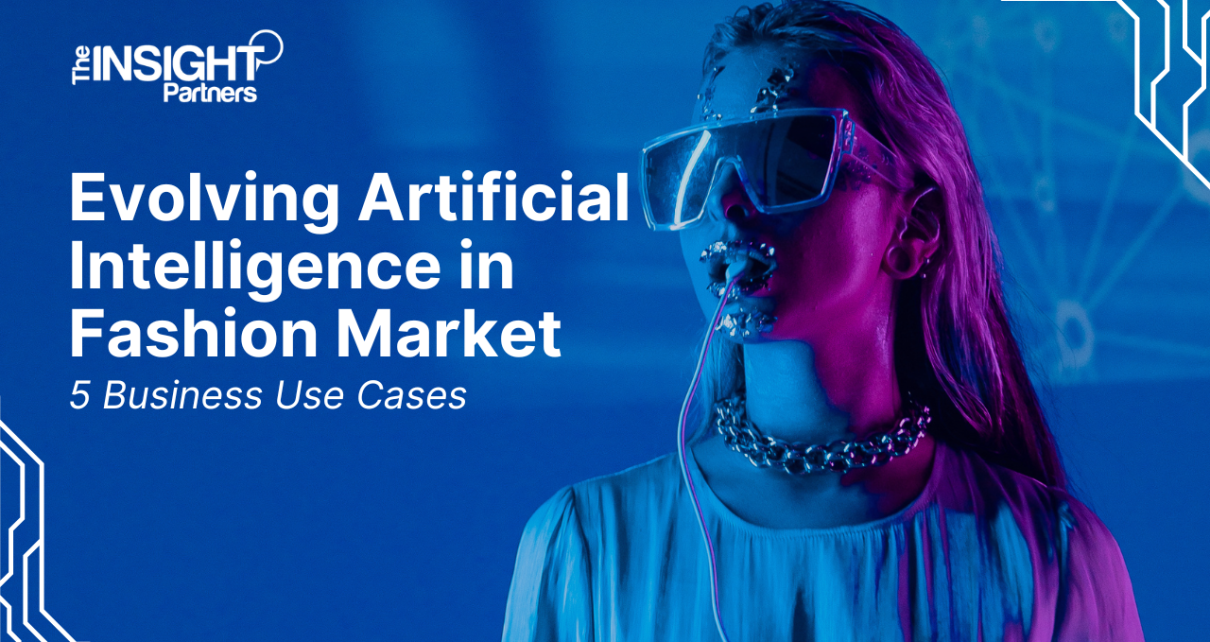Through significant developments, artificial intelligence in fashion market has garnered upward traction in recent years. AI’s effect on fashion is likely to remain multifaceted from optimized supply chains to customized recommendations. Artificial intelligence in fashion is foreseen to inject about USD 250 billion into apparel and luxury sectors in the coming 5 years. Fashion brands embrace advanced tools for the design, production, and marketing of fashion.
Artificial intelligence in fashion market size is expected to cross a valuation of USD 4,391.7 million by the end of 2027, from USD 270.0 million in 2018. The market is estimated to grow at a CAGR of 36.9% during 2019 – 2027.
Fast fashion has emerged as a response to a disposable society, and this subsequent trend is expected to contribute USD 185 billion by 2027. In the present scenario, global artificial intelligence in fashion market is experiencing a shift from conventional on-premise to cloud-based deployments. Brands of all sizes are leveraging AI technologies through social media platforms, e-commerce transactions, and mobiles to understand customers.
Companies investing in artificial intelligence in fashion market research, to keep up with the pace of the growing replacement of products, promising sustainability and inclusivity. However, fast fashion trends are accompanied by environmental costs and regulatory concerns. This article will cover the major business applications and challenges ahead in expanding artificial intelligence in fashion market.
AI in Supply Chain Management – Quality Assurance
The impact of AI in the supply chain is multivariate from predicting demand, to optimizing operations and automating inventories. Businesses may make more educated decisions about what to stock and when by evaluating past inventory levels and sales success. In 2023, Globally about 40% of supply chain companies invested in artificial intelligence.
Computer vision enabled by AI, is increasing quality assurance in the fashion sector. It has reduced downtime and ensured service duration. Vendors are relying on chatbots to negotiate with suppliers. With over 65% of brands in 2023, preferred negotiating with AI than with any staff, it is expected to promote artificial intelligence in supply chain market growth. In the case of large contracts, companies may benefit by investing in AI for supplier relationship management.
Brands foreseen to benefit from investing in AI-powered quality control in their existing workflows. Smart cameras improve inspection and address the cost of fabrication. On-premise or cloud-based AI solutions are impacted by the preparedness of brands to choose new vendors. Increasing preferences for cloud-based AI software in the fashion sector is also a factor stimulating the current artificial intelligence in fashion market scenario.
Operational AI and Workforce Restructuring – Dichotomy of Service Roles
Fashion enterprises leverage AI models to reduce the risk of creating unsellable designs. For instance, Project Muze, by Zalano and Google, uses machine learning to generate fashion designs. However, the introduction of AI models in certain tasks such as content creation, and customer services could lead to workforce restructuring.
Due to the adoption of automation about 23% of jobs are foreseen to change by 2027. This transformation is estimated to create 69 million new roles, followed by a loss of about 83 million jobs by 2027. AI can create a divide between highly skilled workers and menial service roles.
The development of AI models could also create unfair advantages for big market players and barriers for small companies. The growth of open-source AI models is foreseen to create democratized provisions innovation and technologies fostering business rivalry. Combining generative AI with existing technologies is anticipated to augment employee productivity by 0.1 to 0.6% annually through 2040, depending on the rate of adoption and worker’s schedules. Vendors have huge scope to execute Natural Language Programming (NLP) to manage end-to-end interactions between humans and machines.

Artificial Intelligence in Fashion Market – Chatbots as Personal Stylists and Content as an Essential Tactics
Fashion Marketing has become personalized and content-driven. Unstructured data, like consumer sentiments and omnichannel data, are crucial pointers to consider while making decisions. Marketers trying to leverage technology, to gauge the right products to customers.
An active chatbot on the platform is no less than offering a personal stylist to customers. In 2022, about 57% of B2B marketers in the U.S., relied on chatbots for demand generation and knowing their consumers better. Body type and previous purchases form the basis for the chatbot’s suggestions. For instance, Alibaba’s Fashion AI technology offers mix-and-match recommendations, creating a seamless consumer experience and beating the competition.
Content Marketing – An Essential Artificial Intelligence in Fashion Market Trend
Authentic marketing content assists brands to keep a competitive advantage. Investment in AI in marketing accounted for USD 27.4 billion in 2023. In the crowded fashion landscape, content emerging as a business essential. Today about 73% of retail consumers prefer browsing products on multiple channels before buying, that’s why brands exploring an omnichannel strategy.
Content automation AI tools can be leveraged for marketing campaigns and web pages. Content marketing is likely to remain dominant in Europe’s artificial intelligence in the fashion market, as 28.8% of UK fashion sector sales took place online increasing from 20% in 2019.
A paradigm shift in marketing is due to a combined scientific approach and content strategies. Overwhelming customers with promotional emails is not enough today. Brands must appear on Instagram, and be active on Pinterest boards. Brands are likely to gain high returns by investing in data analytics.
AI Can Assist Fashion Brands in Cutting Down Fashion Waste
In 2022, online returns cost about USD 280 billion in the retail industry. With about 87% of all materials ending up in landfills, addressing fashion sector waste is vital for the circular fashion economy in the coming decade.
Brands such as Tommy Hilfiger and H&M deploy AI to understand environmental nuances related to every raw material they use in supply chains and manufacturing to ensure endurance. H&M has introduced “Conscious” as one eco-friendly line of clothing. Zara also labels its products as “Join Life” under sustainability initiatives.
Virtual Try-on to Reduce the Returns
Virtual try-on technology is proving to be better for fashion brand’s bottom lines. It emerged to rescue brands from curbing sales during COVID-19. Luxury brands such as Cartier have introduced hyper-realistic augmented reality technology to create virtual fitting rooms.
Data analytics helps to identify the needed quality of production and address waste. AI suggests sizes and avoids returns from customers. AI can detect trends in the design stage, this can reduce errors by 50%.
AI to Improve Efficiency of Second-hand Clothing and Rental Fashion
AI has the potential to increase the share of the second-hand clothing sector in the coming years. From personalized experiences to reliable costs, AI-driven advancements are set to give new life to clothes.
Rental fashion sector is anticipated to grow with a CAGR of 6.5 by 2026. Consumers are appreciating rental fashion trends as they can access designer clothes without committing a long-term ownership after purchase. AI in rental fashion is expected to open a new niche for investors by optimizing operations, recognizing cleaning methods of garments, and rapidly keeping them sorted within minimal time.
Artificial Intelligence in Fashion Market Without Oversight – Calling for Regulatory Actions
AI can integrate with each segment in fashion value chains, and can easily knock off popular designs. Data generated per click by consumers is further scrutinized by AI. However, massive emphasis on data also has invited privacy concerns.
Fashion models recently urged the state to regulate artificial intelligence in the fashion market. They intend to reserve and keep the rights of their images. Manhattan Senator Brad Holyman-Sigal is considering a bill. The bill would tweak state labor laws. It aims to offer basic protections to independent fashion models. The goal of this regulation is to promote transparency and accountability in the industry. In January 2024, the senator expressed concerns about using artificial intelligence in fashion market.
The blurred lines between AI-authored designs and human work are the main challenge. We tell brands to navigate through available complex copyright methods and monetize their AI-generated work. While exploring the perks, fashion brands can’t afford certain risks.
Wrapping Up
AI in fashion is a relationship of revolution and technology-led disruption. Generative AI promises to make 2020-2030, one of the most exciting decades for fashion. Though it is here to stay as a resurgence in the fashion sector, it has several challenges.
Critics have long scrutinized the fashion industry for its use of new technology. The application of human rights and its impact on human roles are driving concerns. Yet intervention of artificial intelligence in fashion market has changed the fashion scenario to response Industry 4.0. With more involvement from governments, fashion brands can ensure due diligence.
Artificial intelligence in fashion market players, that switch early to emerging technologies are likely to have the upper hand. Business leaders will need an open approach to changes. They need to tackle various ethical and practical challenges. They can shield against breaches and secure the entire supply chain. The ultimate impact of generative artificial intelligence in fashion market depends on how brands advance it in the next decade.
References-
Forbes- Artificial Intelligence in Fashion
The Guardian- ‘You’ve got to be data-driven’: the fashion forecasters using AI to predict the next trend
The New York State Senate- “Senator Hoylman-Sigal and Fashion Models Urge State to Regulate Artificial Intelligence”
MDPI – Unveiling the Soaring Trend of Fashion Rental Services: A U.S. Consumer Perspective



